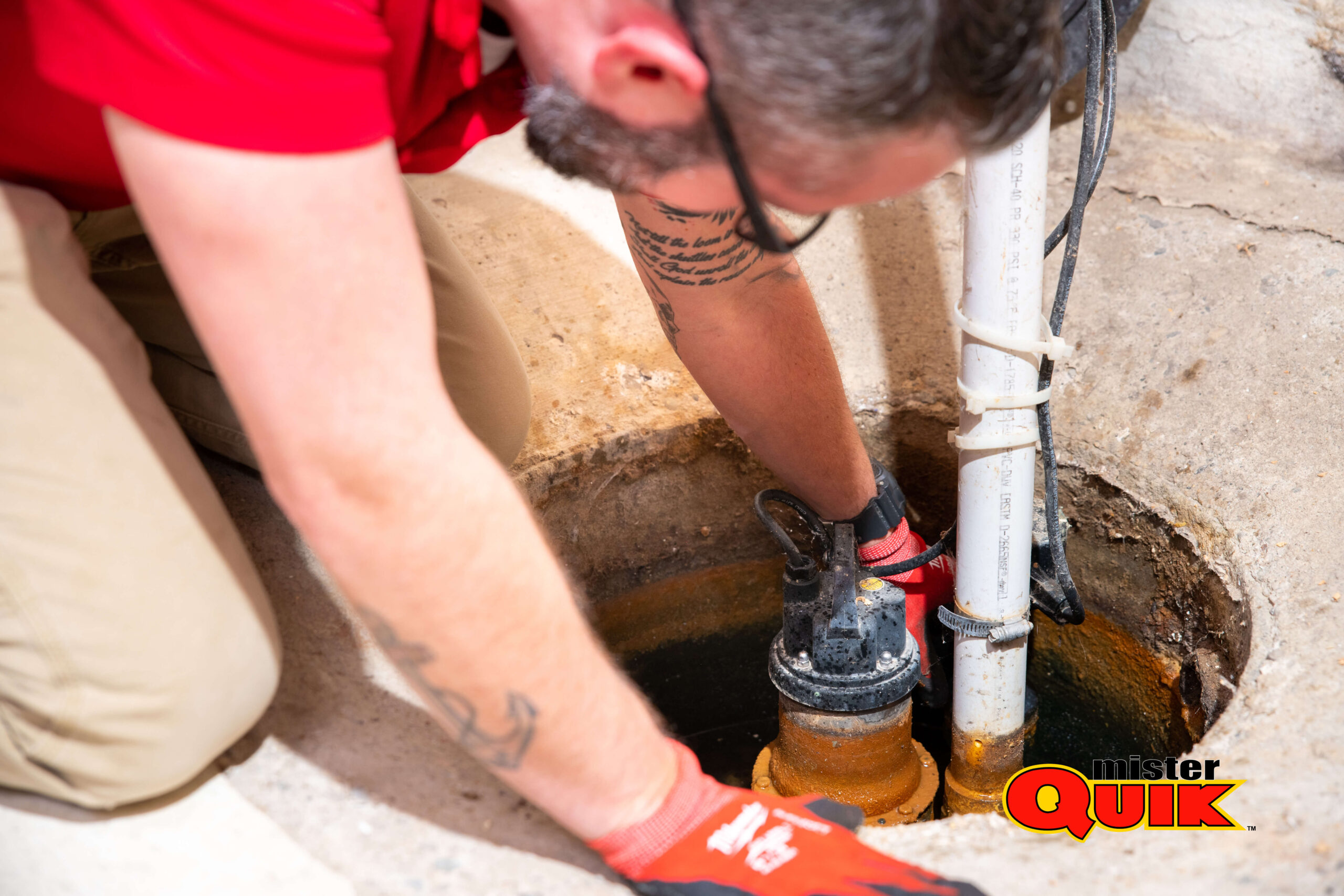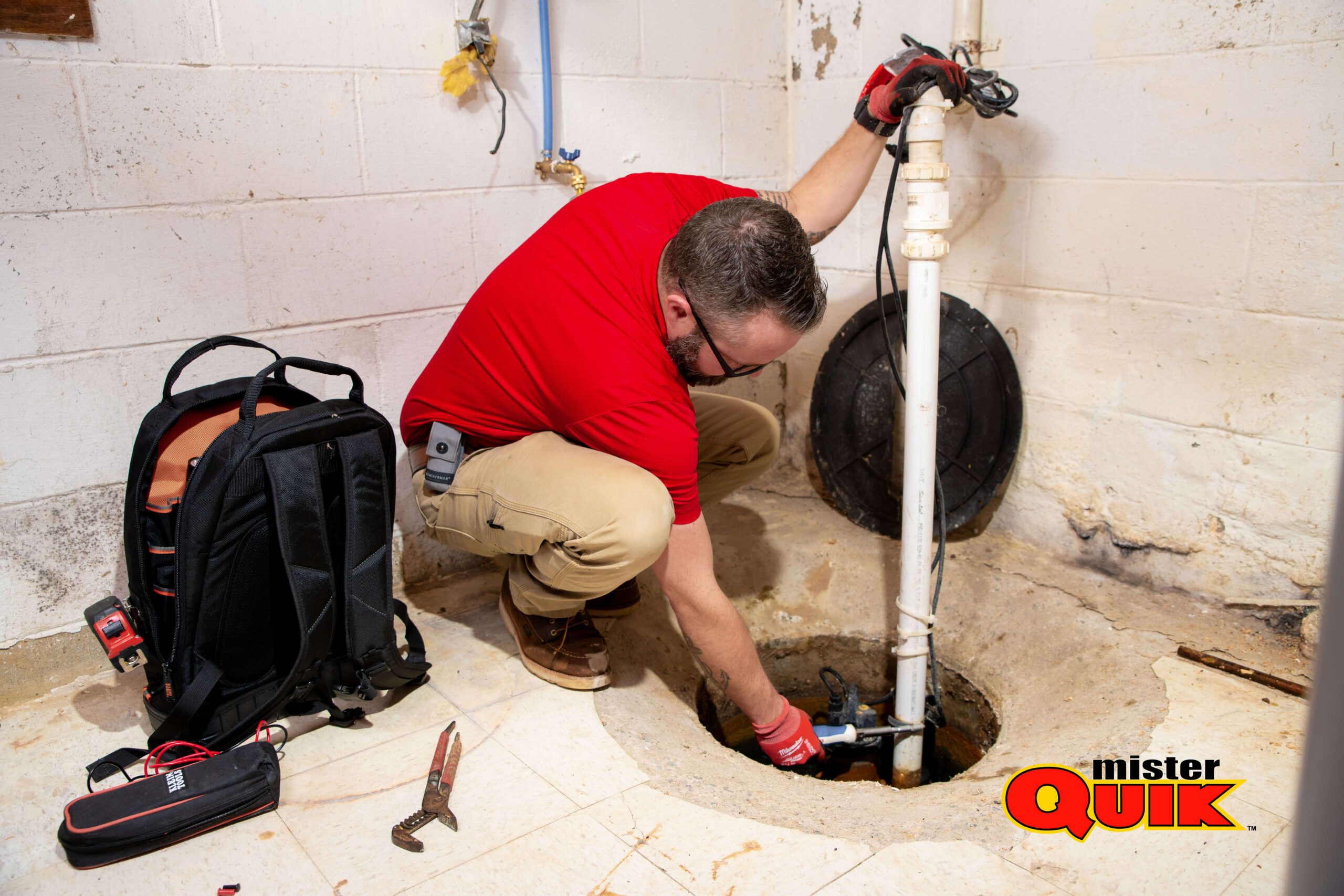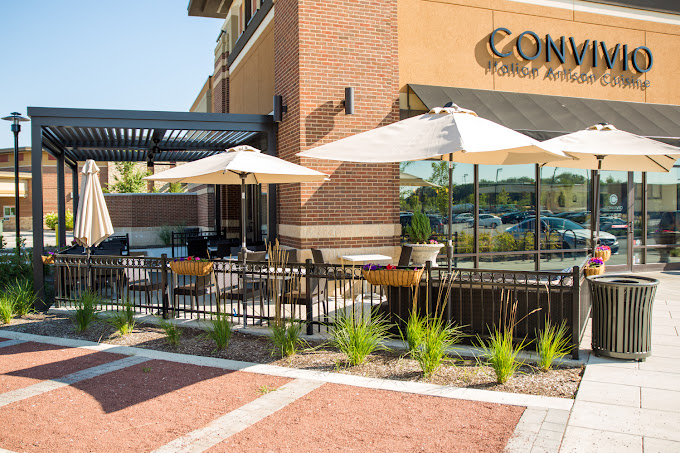Sump Pump Installation

What is a sump pump
A sump is a crucial component in home waterproofing systems, especially in areas prone to flooding or high water tables. Understanding what a sump is and how it works can help homeowners protect their property from water damage. Here’s everything you need to know about sumps:
- Purpose: A sump is a pit or reservoir installed in the lowest part of a basement or crawlspace to collect excess water.
- Function: When groundwater or rainwater accumulates around the foundation, the sump collects it, preventing it from seeping into the home.
- Components: A typical sump system consists of a sump pit, a sump pump, and a discharge pipe.
- Sump Pit: This is the hole dug into the ground where water collects. It’s usually lined with gravel to facilitate water flow.
- Sump Pump: The pump sits inside the sump pit and is responsible for removing water from the pit and pumping it away from the foundation.
- Discharge Pipe: This pipe carries the pumped water away from the house, usually directing it to a storm drain or a safe drainage area.
- Types: There are two main types of sump pumps: pedestal and submersible. Pedestal pumps have the motor mounted above the sump pit, while submersible pumps are fully submerged in water.
- Activation: Sump pumps are typically activated by a float switch, which turns the pump on when the water level in the pit reaches a certain height.
- Importance: Sumps play a critical role in preventing basement flooding and water damage, especially during heavy rains or melting snow.
- Maintenance: Regular maintenance, including cleaning the pit, testing the pump, and inspecting the discharge pipe, is essential to ensure the sump system functions properly.
- Installation: Proper installation of the sump and pump is vital for effective water removal and long-term reliability.
In conclusion, understanding what a sump is and how it functions is essential for homeowners looking to protect their property from water damage. For expert advice and installation services, trust in the expertise of Mister Quik Home Services in Carmel.
How Do sump pumps work
Sump pumps are your home’s unsung heroes, quietly protecting your basement from flooding. Understanding their inner workings can demystify their operation. Here’s a detailed breakdown:
Sump pumps sit in a sump pit, typically dug at the lowest point in your basement, collecting water.
When groundwater or excess water enters the pit, it triggers the sump pump to activate.
Most sump pumps use a float switch, resembling a ball or cylinder, to detect rising water levels.
As the water level rises, the float switch rises with it, triggering the pump to turn on when it reaches a certain height.
Once activated, the pump’s motor powers an impeller, a fan-like component that spins rapidly.
The spinning impeller creates a centrifugal force, drawing water into the pump.
The impeller then expels the water through a pipe, directing it away from your home’s foundation.
A check valve prevents water from flowing back into the pit after the pump shuts off.
As the water level drops, the float switch lowers, deactivating the pump until water levels rise again.
Regular maintenance, including cleaning the pump and testing the float switch, ensures optimal functionality.
Understanding how sump pumps work empowers homeowners to maintain a dry and safe basement environment. Trust in the expertise of Mister Quik Home Services in Carmel for all your sump pump needs, ensuring peace of mind during heavy rains and floods.
Yes, plumbers install sump pumps as part of their services. Sump pumps are essential for preventing basement flooding by removing excess water, and plumbers have the expertise to handle the installation process. They can assess the specific needs of a property, determine the appropriate sump pump size and type, and ensure proper integration with existing plumbing systems. If homeowners or businesses require a sump pump installation, hiring a qualified plumber is a practical choice to ensure the job is done correctly and efficiently.
Yes, a sump pump can be installed after a house is built. While it’s typically more straightforward to install a sump pump during the construction phase, retrofitting one into an existing home is a common practice. The process involves creating a sump pit in the basement or crawl space, installing the pump within the pit, and connecting it to a discharge pipe that directs water away from the foundation. Professional plumbers or waterproofing specialists can assess the home’s layout, groundwater issues, and specific needs to determine the most effective installation method for the sump pump retrofit.
The lifespan of a sump pump typically ranges from 3-4 years, but it can vary based on factors such as the quality of the pump, frequency of use, and maintenance practices. Regular maintenance, including cleaning the pump and checking for any signs of wear or damage, can help extend its lifespan. It’s advisable to monitor the pump’s performance and consider replacement if you notice any decline in efficiency or reliability.
In general, a properly functioning sump pump that helps prevent basement flooding and water damage can enhance rather than lower home value. It demonstrates proactive measures taken to protect the property from potential water-related issues, which can be appealing to prospective buyers. Ultimately, the effect on home value depends on the overall condition of the property and how well the sump pump system is integrated and maintained.
Yes, a basement can still flood with a sump pump in certain situations. While sump pumps are effective at managing groundwater and preventing flooding in many cases, they are not foolproof. Power outages, pump failures, excessive water inflow, or issues with the pump’s installation can compromise its effectiveness. Regular maintenance, having a backup power source, and addressing potential sources of water entry are crucial steps to enhance the reliability of a sump pump and minimize the risk of basement flooding.
Types sump pump
Sump pumps are crucial for preventing basement flooding, but not all are the same. Understanding the different types can help you choose the best one for your needs. Here’s a comprehensive guide to the various types of sump pumps available:


Submersible Sump Pumps:
- Installed inside the sump pit.
- Submerged in water during operation, making them quieter.
- Ideal for basements where space is limited.
Pedestal Sump Pumps:
- Motor located above the sump pit.
- Easier to service but potentially noisier.
- Suitable for larger basements or crawl spaces.
Battery Backup Sump Pumps:
- Provide protection during power outages.
- Ensure continuous operation in emergencies.
- Essential for areas prone to frequent power cuts.
Water-Powered Sump Pumps:
- Operate using water pressure from your home’s supply.
- No need for electricity or batteries.
- Reliable backup option for areas with reliable water sources.
Primary AC-Powered Sump Pumps:
- Connected to your home’s electrical system.
- Efficiently pumps water out of the sump pit.
- Requires a backup power source for uninterrupted operation.
Combination Sump Pumps:
- Combine features of both submersible and pedestal pumps.
- Provide versatility and reliability.
- Suitable for various basement configurations.
Water-Powered Backup Sump Pumps:
- Utilize municipal water pressure to pump out water.
- No need for batteries or electricity.
- Ideal for areas with reliable municipal water supply.
DC-Powered Sump Pumps:
- Operate using direct current (DC) power source.
- Energy-efficient and quieter operation.
- Suitable for eco-conscious homeowners.
High-Head Sump Pumps:
- Designed for pumping water over longer distances or uphill.
- Ideal for properties with unique drainage requirements.
- Ensure efficient water removal even in challenging conditions.
Heavy-Duty Sump Pumps:
- Built to handle high volumes of water and debris.
- Suitable for industrial or commercial applications.
- Provide robust performance and durability in demanding environments.
In conclusion, understanding the different types of sump pumps available empowers homeowners to make informed decisions when selecting the best option for their property. For expert advice and installation services tailored to your needs, trust in the expertise of Mister Quik Home Services in Carmel.
Sump Pump Basin
Are you curious about sump pump basins and how they safeguard your home from water damage? Understanding the role and components of a sump pump basin is crucial for effective water management. Here’s a detailed overview to enlighten you:


Sump pump basins collect water from drainage systems and groundwater to prevent flooding in basements or crawl spaces. They provide a reservoir for the sump pump to draw water from, ensuring efficient removal and discharge. Basins are typically made of durable materials like polyethylene or fiberglass to withstand constant exposure to water and soil.


Lid/Cover: Keeps debris out of the basin and prevents safety hazards. Pump Stand: Elevates the sump pump to avoid debris accumulation and ensure proper water intake. Perforations: Allow water to enter the basin while filtering out larger debris. Sump Pump Pit: Houses the sump pump and serves as a collection point for water. Discharge Pipe Connection: Allows water to be expelled from the basin to the exterior of the home.






Basins come in various sizes to accommodate different water volumes and pump capacities. Choosing the right size ensures sufficient water storage and prevents overflow during heavy rainfall. Factors like basement size, drainage area, and average water table depth influence basin size selection.






Proper installation is critical for the effective operation of a sump pump system. Basins should be placed in the lowest point of the area prone to water accumulation. The basin should be securely anchored to prevent shifting or movement during operation.






Regular maintenance ensures the sump pump basin functions optimally and prolongs its lifespan. Inspect the basin and pump for debris buildup, corrosion, or damage. Clean the basin and check the pump operation periodically to prevent clogs and malfunctions.






Consider installing a backup sump pump system to provide redundancy in case of primary pump failure. Battery-powered or water-powered backup pumps can supplement the primary pump during power outages or mechanical issues.






Sump pump basins help prevent basement flooding, protecting your property from water damage and mold growth. They provide peace of mind, especially during heavy rains or thawing periods when the risk of water infiltration is high. Properly maintained basins and sump pump systems increase the value and resale potential of your home.
In conclusion, sump pump basins are essential components of a comprehensive water management system, safeguarding your home against potential flooding and water damage. For professional assistance with sump pump installation, maintenance, or repairs, rely on the expertise of Mister Quik Home Services in Carmel.
Sump and Pump installation
If you’re considering sump and pump installation, you’re taking a proactive step in safeguarding your home against water damage. Understanding the installation process and its components is crucial for ensuring effective flood prevention. Here’s what you need to know:
Assessment: Begin by assessing your basement’s layout, water accumulation patterns, and potential flood risks to determine the most suitable location for the sump pit and pump.
- Evaluate the depth and size of the sump pit required based on your basement’s water volume and drainage needs.
- Consider factors such as soil composition, groundwater levels, and local climate conditions when planning the installation.
Sump Pit Preparation: Excavate the designated area for the sump pit, ensuring it’s deep enough to accommodate the pump and allows adequate drainage.
- Install a layer of gravel at the bottom of the pit to promote water filtration and prevent debris from clogging the pump.
- Position the sump pump basin securely in the pit, ensuring it sits level and stable to support the pump’s weight.
Pump Selection: Choose the appropriate type and size of the sump pump based on factors like basement size, water volume, and pumping capacity requirements.
- Submersible pumps are typically installed inside the sump pit and are ideal for basements with limited space.
- Pedestal pumps feature a motor mounted above the pit, making them easier to service but requiring more space.
Installation: Connect the sump pump to the discharge pipe, ensuring a secure and watertight seal to prevent leaks.
- Position the check valve in the discharge pipe to prevent water from flowing back into the sump pit once the pump shuts off.
- Test the pump to ensure it activates properly and effectively removes water from the pit.
Backup Systems: Consider installing a battery backup or water-powered backup system to provide additional protection during power outages or pump failure.
- Battery backup systems use rechargeable batteries to power the pump when electricity is unavailable.
- Water-powered backup systems rely on municipal water pressure to operate the pump during emergencies.
Electrical Wiring: Ensure the sump pump is properly wired to a dedicated electrical circuit and grounded to prevent electrical hazards.
- Hire a qualified electrician to handle the electrical wiring and ensure compliance with local building codes and safety standards.
- Install a ground fault circuit interrupter (GFCI) to protect against electrical shocks and malfunctions.
Testing and Maintenance: Regularly test the sump pump to verify its functionality and performance, especially before the rainy season or periods of heavy rainfall.
- Conduct routine maintenance tasks such as cleaning the pump, checking the float switch, and inspecting the discharge pipe for clogs or obstructions.
- Keep a record of maintenance activities and schedule periodic inspections by a qualified technician to identify and address any issues promptly.
In conclusion, sump and pump installation is a proactive measure to prevent basement flooding and protect your home from water damage. By understanding the installation process and following proper procedures, you can ensure effective flood prevention and peace of mind. Trust Mister Quik Home Services in Carmel for expert sump and pump installation tailored to your home’s needs.
Sump Pump Cost to install
Are you considering installing a sump pump but unsure about the costs involved? Understanding the factors influencing sump pump installation costs can help you budget effectively. Here’s an informative guide to sump pump cost to install:
Submersible pumps are typically more expensive due to their design and installation complexity. Pedestal pumps are usually more affordable but may require additional space for installation.
Higher capacity pumps designed to handle larger volumes of water may cost more upfront. Consider your basement size and potential water volume to determine the appropriate pump capacity.
Electric-powered sump pumps are common and cost-effective but require access to an electrical outlet. Battery backup systems add to the initial cost but provide peace of mind during power outages.
Factors such as the layout of your basement and existing drainage systems can affect installation costs. Additional plumbing or electrical work may be required, depending on your home’s configuration.
Higher-quality pumps from reputable brands may have a higher upfront cost but offer better performance and reliability. Consider the long-term benefits of investing in a durable sump pump that requires less frequent maintenance and repairs.
In conclusion, the cost to install a sump pump varies depending on factors such as the type of pump, capacity, power source, installation complexity, quality, professional installation, warranty, additional features, local regulations, and long-term savings. By understanding these factors, you can make an informed decision and invest in a sump pump that provides reliable protection for your home.
For expert guidance and professional sump pump installation services, trust Mister Quik Home Services in Carmel. We’re here to ensure your basement stays dry and your home remains protected from water damage.
Troubleshoot Checklist:
- Evaluate basement layout, water accumulation patterns, and flood risks.
- Consider soil composition, groundwater levels, and local climate conditions.
- Ensure the pit is deep enough and lined with gravel for proper drainage.
- Securely position the sump pump basin and level it to support the pump.
- Choose between submersible and pedestal pumps based on space availability.
- Consider pump capacity and activation method (float switch) for efficient operation.
- Connect the pump to the discharge pipe with a secure, watertight seal.
- Install a check valve in the discharge pipe to prevent backflow into the pit.
- Regularly test the pump to verify functionality, especially before rainy seasons.
- Conduct routine maintenance tasks such as cleaning the pump and inspecting for clogs.









